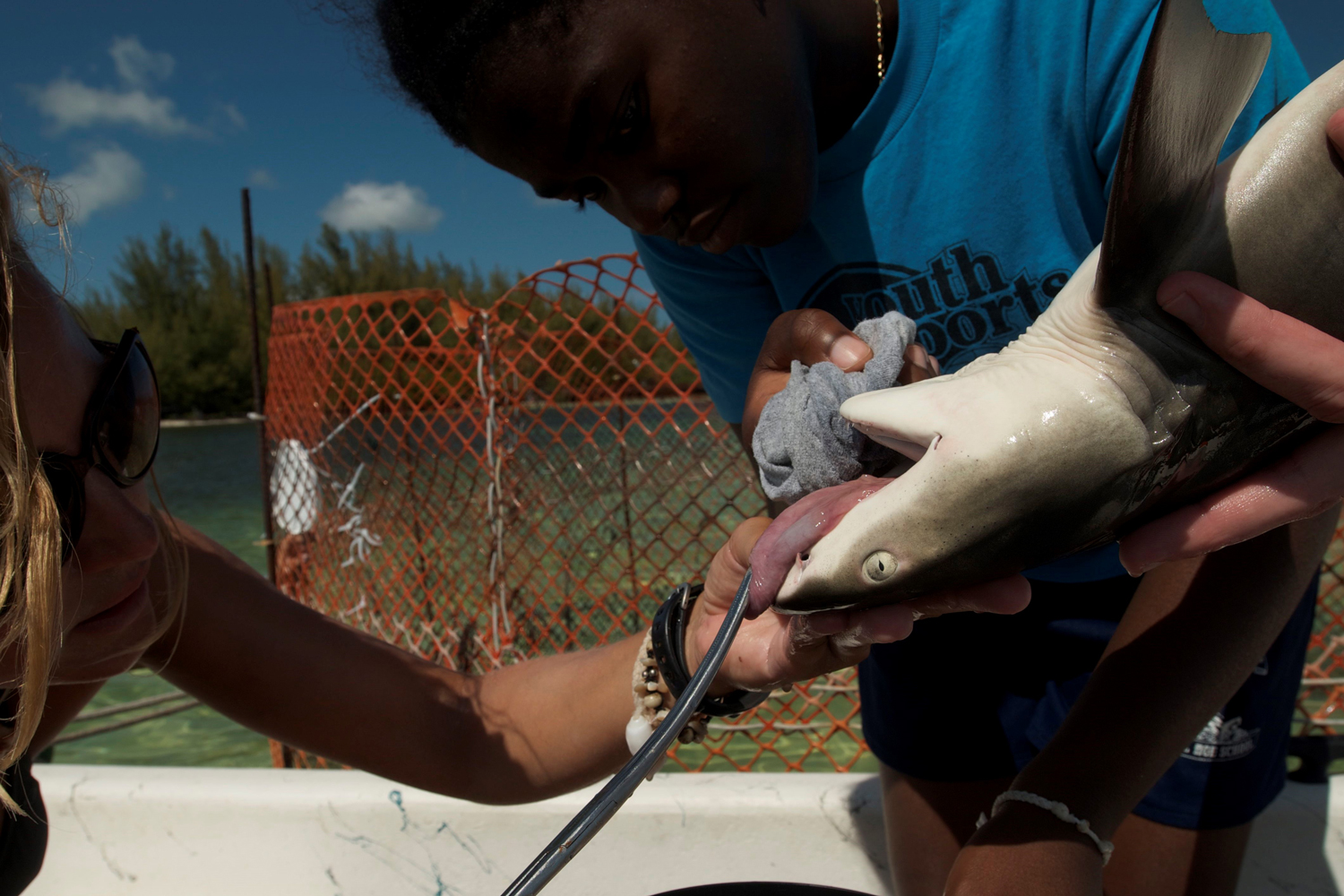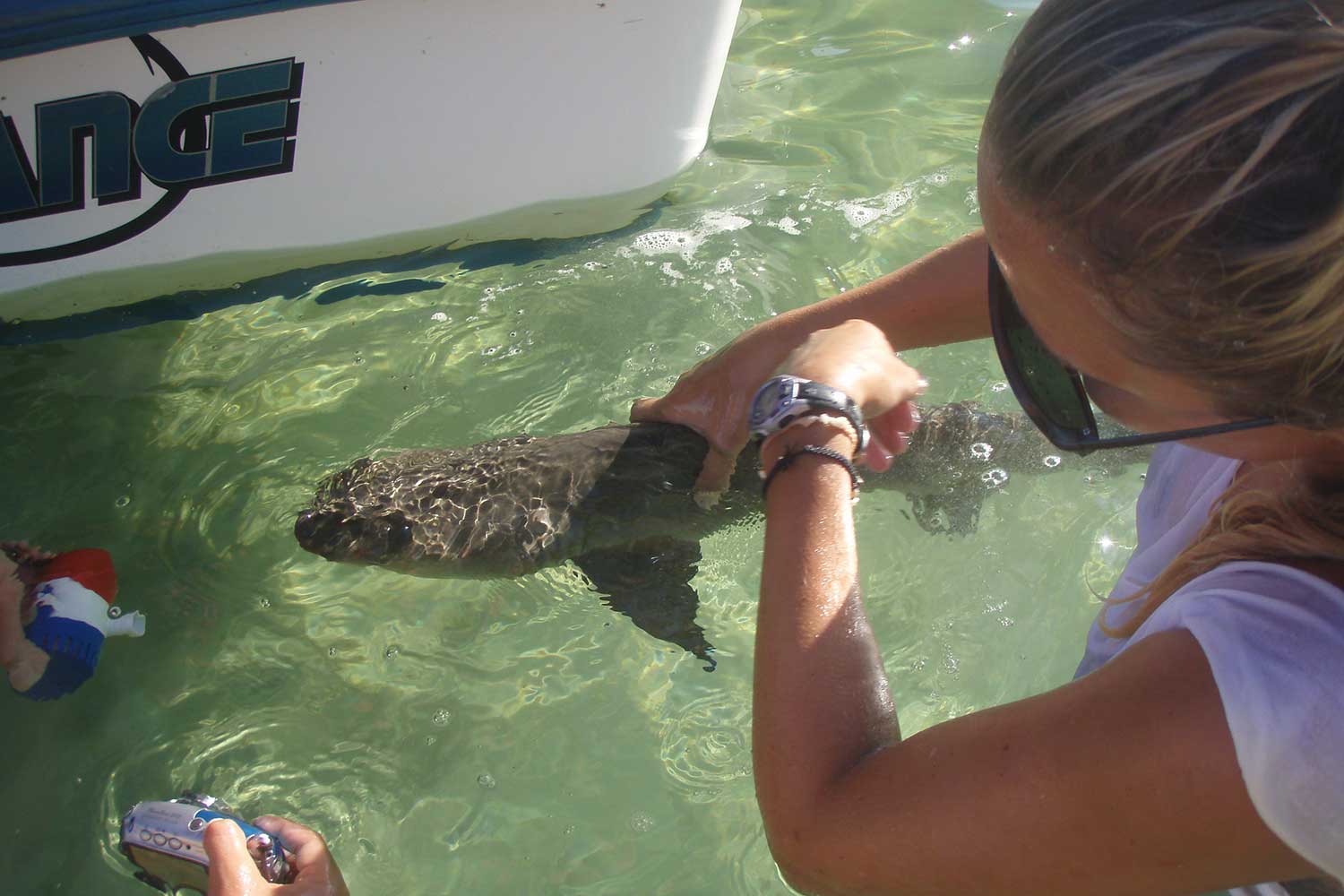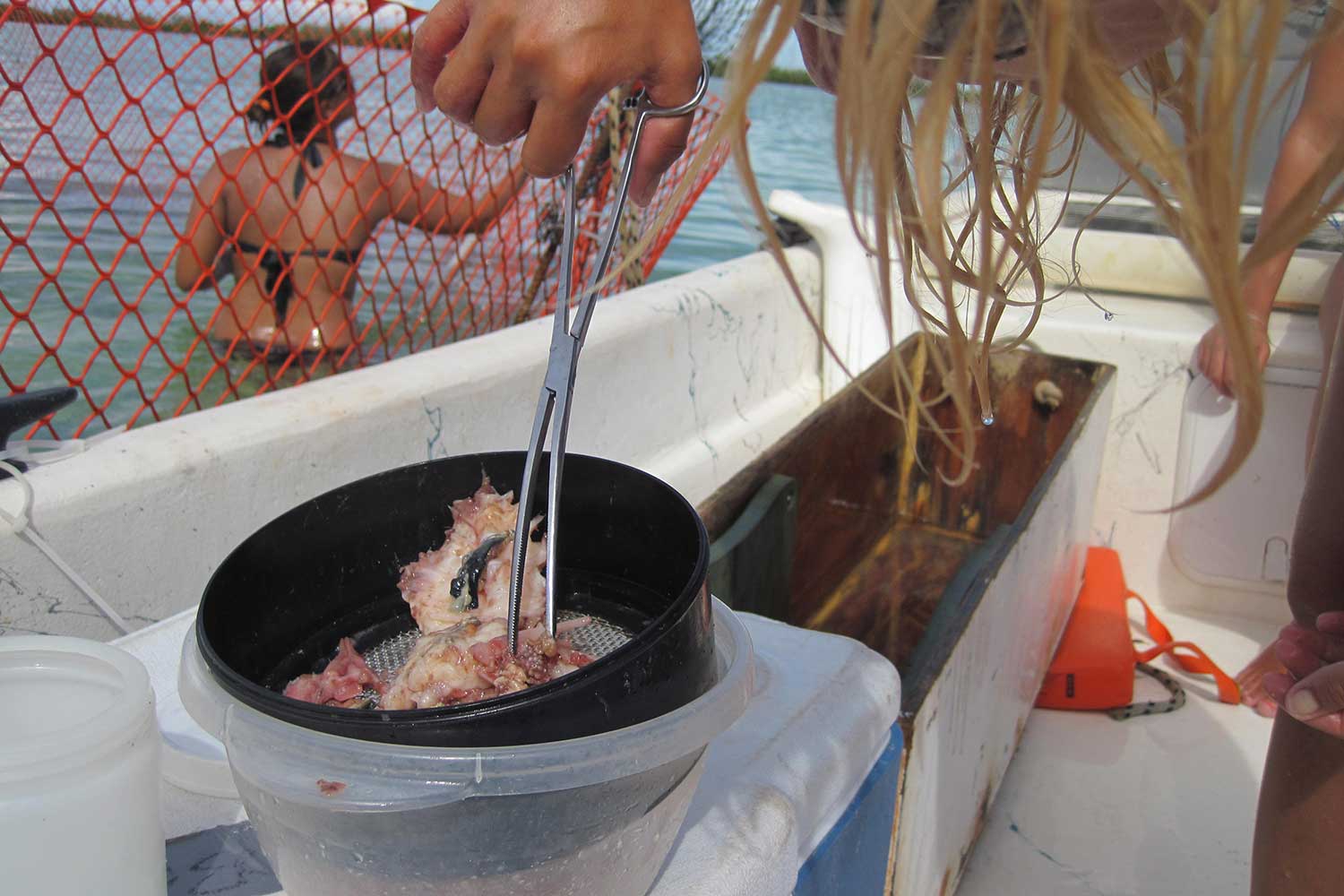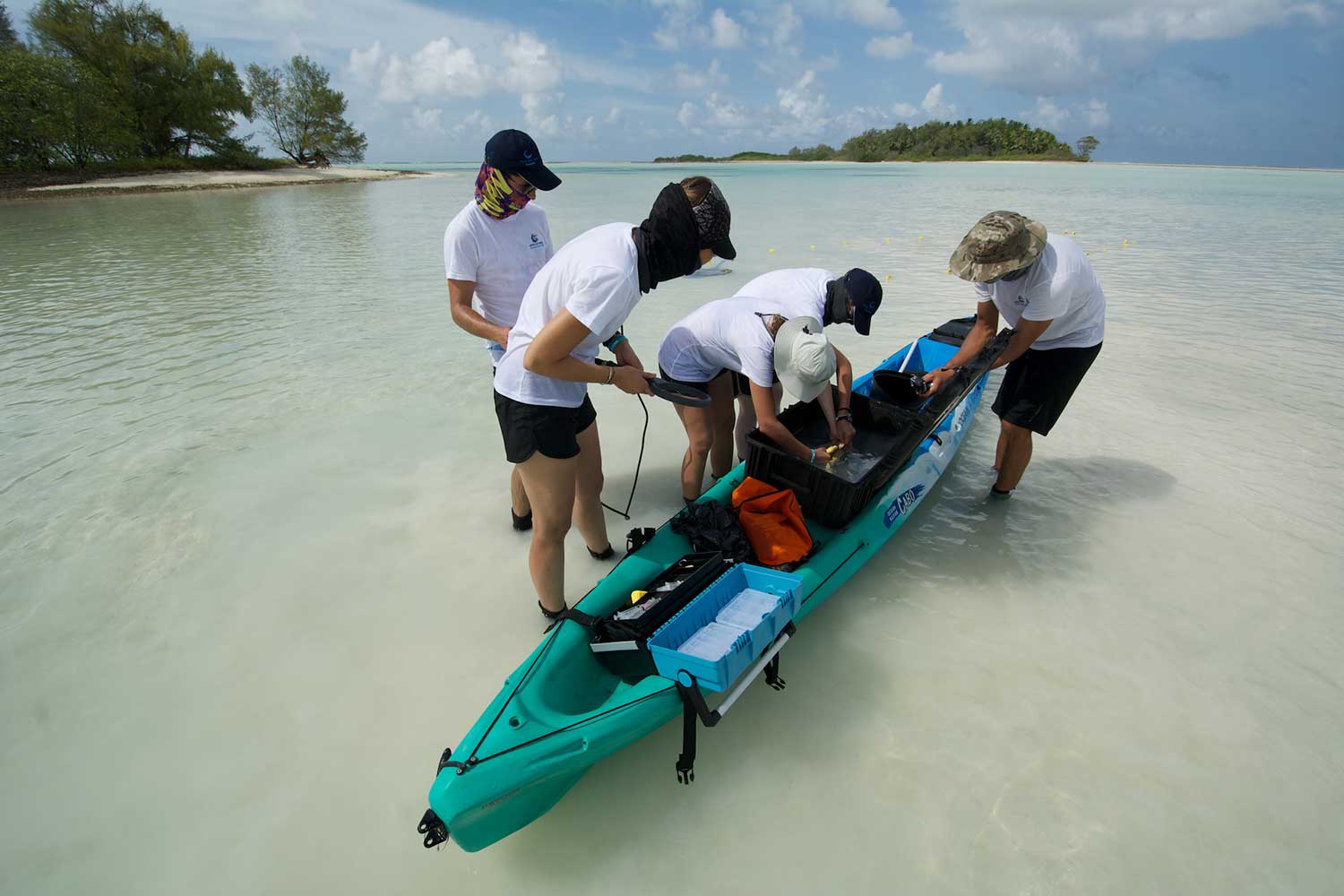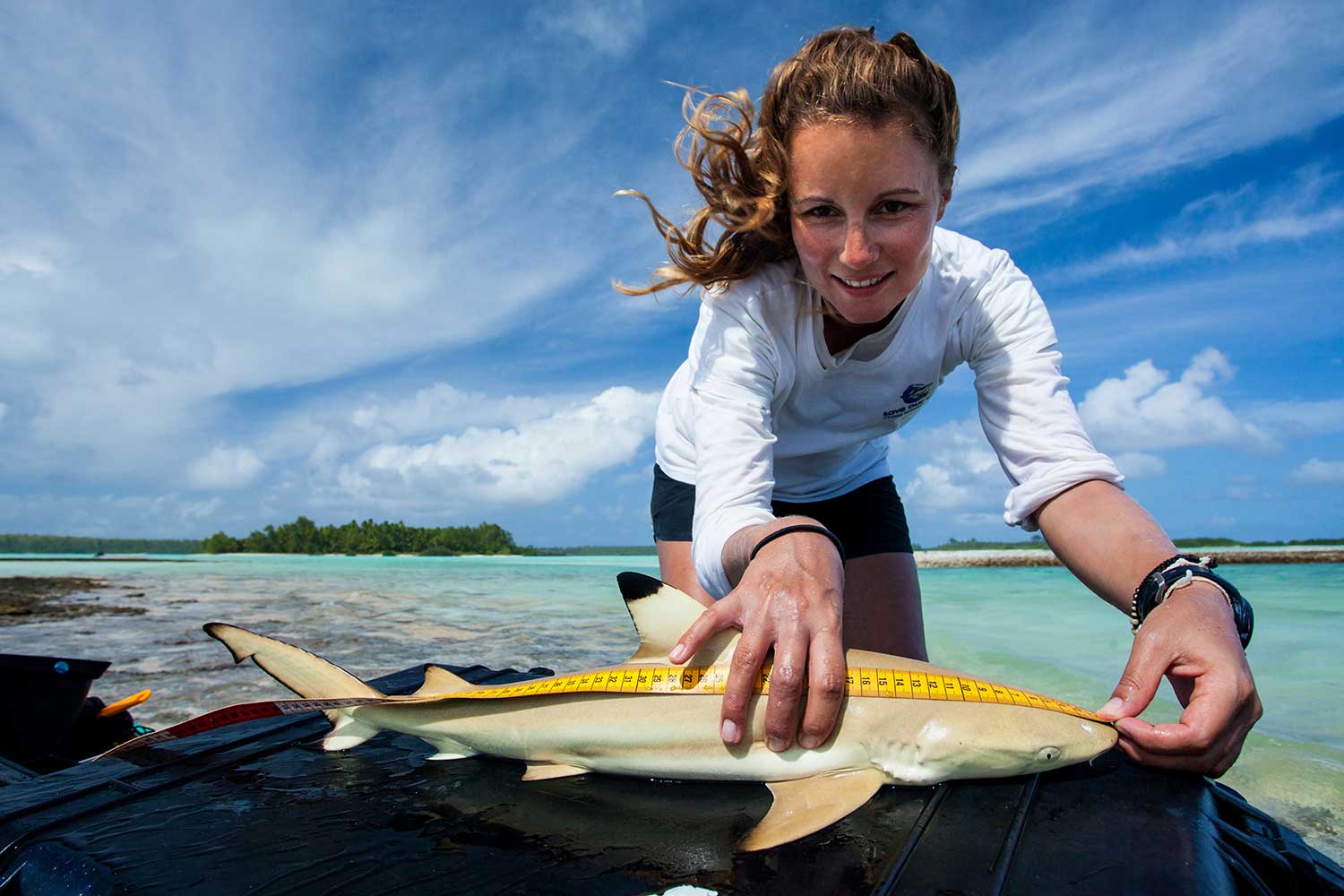Coast guard – nursery habitats for sharks
Where do female sharks give birth? How big or how small are shark pups when they are born? How do the pups survive their first months of life? What do they eat? For viviparous (live-bearing) sharks these questions are mostly unanswered. The reason? The pups of most shark species are born in deep (pelagic) waters that are logistically challenging to study. Some sharks, however, choose coastal, near-shore areas to give birth, habitats that are likely to be more accessible to scientists. But growing up inshore comes at a price for young sharks; the coast is also hot property for humans. For the past 11 years, Ornella Weideli has been investigating young reef sharks in The Bahamas, the Seychelles and French Polynesia and has witnessed the impact of the advance of humans into young sharks’ territory.
The invisible shark
After a sleepless night in a cheap motel room somewhere in Fort Lauderdale, USA, I’m sitting in a tiny plane flying to Bimini in The Bahamas. I still can’t believe that I, a new undergraduate biology student from landlocked Switzerland, have been accepted as a volunteer at the renowned Bimini Biological Field Station (BBFS, also known as the SharkLab). Until this day in September 2009, I haven’t seen a shark in the wild, so I have no idea what’s waiting for me. After only 20 minutes, our plane lands on Bimini’s runway and we are guided to the small airport building. Usually, the SharkLab’s volunteers arrive in small groups; in my case, however, I’m on my own. There’s neither a real welcome nor an introduction to the lab, the staff, the other volunteers or the scientific projects being conducted. I quickly realise that I have to be strong and independent and must mingle with the group if I’m to adapt to daily life at the SharkLab.
A lemon shark swims through Bimini's grass beds, with researchers in the distance. Photo by Félicie Dhellemmes | © BBFSF - SharkLab
The next day, I’m sitting in a six-metre (20-foot) boat with two American volunteers and we are heading to North Bimini to ‘track juvenile lemon sharks in the North Sound nursery’. Track lemon sharks? North Sound? Nursery? All these terms are foreign, but my English is too rusty to ask for any clarification. Instead, I sit quietly in the boat and look around me. I feel pure excitement for whatever the day may bring and settle in to enjoy this ‘commute’. Our route has carried us around the beautiful island of South Bimini, across the channel that divides the South Island from the North Island and past tiny, colourful Bahamian houses that I instantly fall in love with. Then the scene changes. As we continue northward, the docks and boats to my left grow bigger and fancier and numerous construction sites spring up around us. Still constrained by my lack of English, I turn to watch the scenery passing along my right-hand side instead, leaving the question of what all this construction means hanging unanswered in the air between my fellow volunteers and me. A beautiful lagoon appears to my right. This must be the North Sound nursery I’ve been told about – the place where I’ll finally see my first shark!
Or so I thought… As it turns out, my first day in the field is entirely different to what I’ve imagined. Instead of seeing sharks, I have to listen for them. My ears tune in to a digital ‘ping’ relayed on headphones. A tagged shark, detected on the receiver underwater, has its location transmitted to us in real-time so that we can track its movements. We follow the loud ping that is moving steadily between the mangroves and the adjacent patches of sand and seagrass. To keep up with it we turn our boat in circles, sometimes putting the engine into reverse and, when the water gets too shallow, even pushing our trusty craft. It’s hard work, it’s hot and very humid and I’m feeling rather helpless. What exactly are we doing here? Why are we following a juvenile lemon shark for eight hours straight? How can this help to contribute to science and the conservation of sharks? Late in the afternoon, my thoughts are interrupted by one of the volunteers calling it quits for the day. With little explanation, we pack up our gear, start the engine and return to the SharkLab.
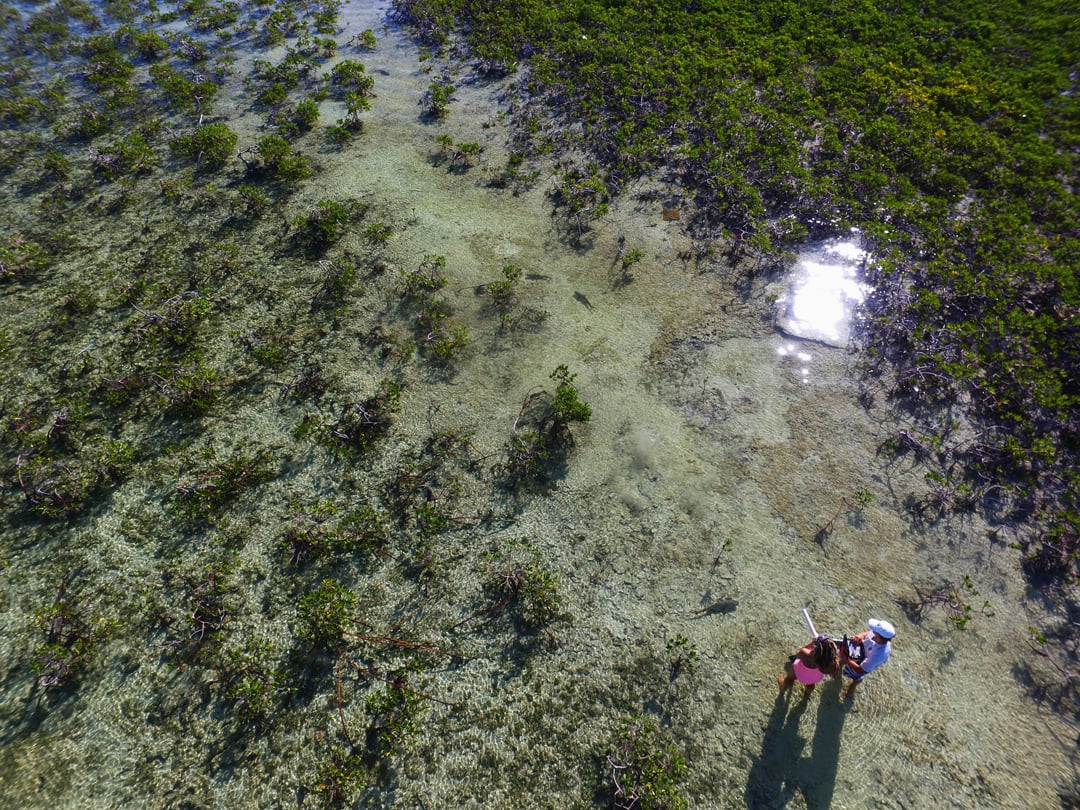
Two volunteers got out of the boat to listen for our usual suspects in a known aggregation spot, the “Nap spot”. Photo by Félicie Dhellemmes | © BBFSF - SharkLab
Thinking back to this first day in the field, I realise how little I knew about science, sharks, fieldwork and the importance of near-shore areas. While I saw the docks, boat channels and many construction sites on the western side of the lagoon, I wasn’t yet aware of how vital the lush mangroves to the east are for young sharks and the entire ecosystem. And I couldn’t know that this first day was the start of many months that I’d spend in shallow, near-shore habitats looking for juvenile sharks – all the while confronted with the various impacts of our human footprint on these youngsters.
Delving into the diet of sharks
A little over a year later, in January 2011, I find myself once again on a six-metre boat in Bimini’s North Sound shark nursery. This time, I know what I’m looking for. I am on the hunt for juvenile lemon sharks – more specifically, juveniles with full stomachs. I’ve chosen to study the diet of young lemon sharks for my Master’s thesis. To many fellow students back in Switzerland, this seemed an awkward topic to study, but I’m fascinated by what these sharks are eating. The dietary patterns of many shark species are still mostly unknown, so I’m hugely motivated to provide new insights in this field.
After a 20-minute ride we arrive at our destination, a shallow, hidden area on the western side of the North Sound nursery. We set our 180-metre (591-foot) gill net perpendicular to the shoreline and wait for the young sharks. What a difference one day makes! Yesterday we were fishing on the eastern shore, where mangroves are abundant and lush. And here we are today, on the other side of the lagoon, where not a single mangrove remains. However devastating it may look, it’s important for us to be able to compare the sharks’ diets from both shores.
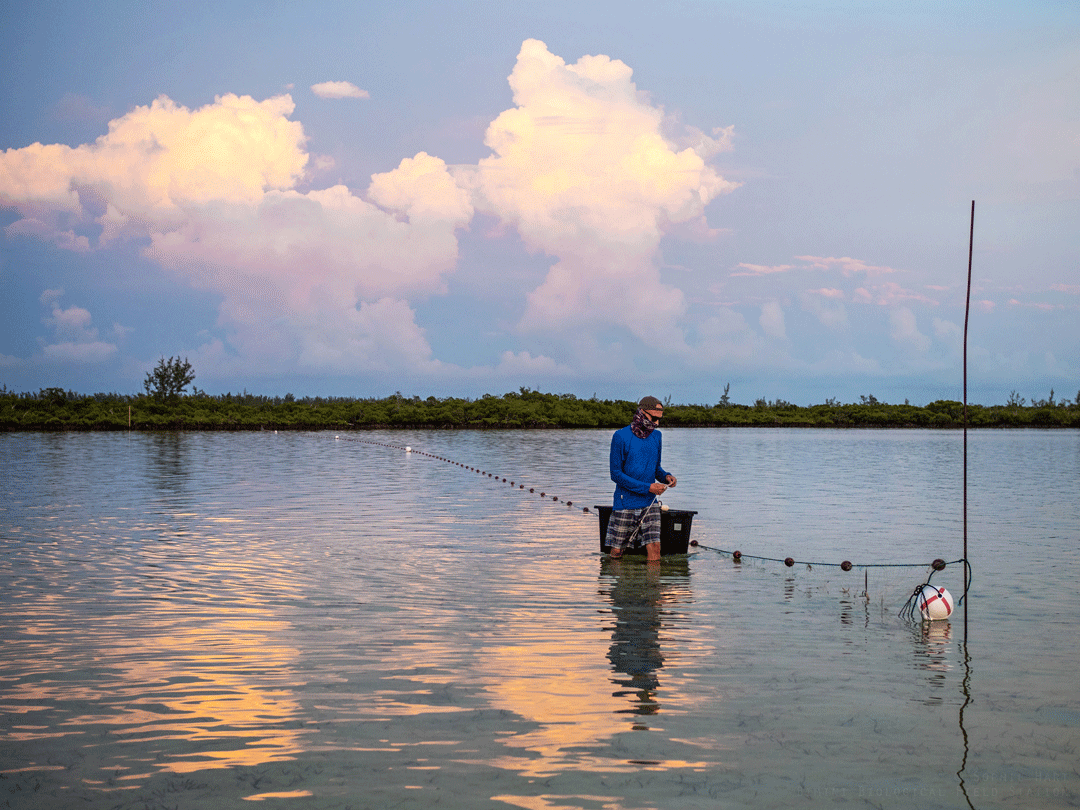
Walking the gillnet. Photo by Sophie Hart | © BBFSF - SharkLab
Splash! Our gill net moves and jerks. I jump out of the boat and walk as fast as I can in the hip-high water to the net, where a shark must be trapped. A young lemon shark is entangled in the net, but I free it as quickly as I can. For its small size, it’s quite strong and tries to wriggle out of my hand. I hold it firmly and put it in a large, water-filled box. As I push the box back to the boat, I know that our team is ready to collect data.
We finish our regular work-up – a process that includes measuring the shark’s size and body mass as well as tagging it – and then perform a procedure to make the shark vomit, for the benefit of my Master’s project. Making a young shark vomit or, in technical terms, everting it, may sound horrifying, but it’s an efficient, non-lethal method to find out what is inside its stomach. First, we anaesthetise the shark. As soon as it is asleep, which takes no more than 20 seconds, we lift it out of the water and open its mouth with long forceps. While everyone looks inquisitively at the shark’s mouth, I carefully grab the far end of its stomach and pull it out. A large white piece of fish and two small fishing hooks drop into the sieve. Before we can investigate these contents, however, our priority is the safety of the shark. I use my forceps to push the stomach gently back into the body cavity and jump into the water to flush the anaesthetic out of the shark’s gills using a small bilge pump. Pretty soon the shark starts moving again and we release it into a small enclosure pen where it can recover safely from being anaesthetised.
Back in the boat, we finally have time to investigate the items we recovered from the shark’s stomach. What we see is both good news and bad. We’re happy to see that the shark is eating, but the presence of small fishing hooks in its stomach is worrisome. This means that humans are impacting this nursery. Luckily for this particular little shark, however, we’ve been able to remove the hooks. But I can’t help wondering how many more small hooks I will find in these sharks’ stomachs.
Fortunately, fishing hooks turned out to be a rare find in the 201 shark stomachs that I everted for my Master’s thesis. Instead, I found mostly the remains of small reef fishes and crustaceans. Just as young lemon sharks depend on mangrove and shallow sea-grass habitats, their favoured prey items – young fish, crabs and shrimp – also rely on these near-shore habitats as nurseries. The more I realise how vital untouched, near-shore habitats are for young sharks and their prey, the more distressed I become about the proliferation of buildings, boat channels and docks, and the overall increase in human influence on North Bimini. It seems so difficult to fight against the steady encroachment of humans. So I leave Bimini in August 2011 with a strange combination of sadness and immense motivation. At this point, there are two items on my agenda: first, I will finish my Master’s degree; and second I want to earn a PhD by continuing my investigations of young sharks and finding a way to contribute to protecting sharks and their near-shore habitats.
St Joseph Atoll. Photo by Michael Scholl | © Save Our Seas Foundation
A deceptive beauty
It’s now March 2017. For the past three years I’ve been coming to St Joseph Atoll in the Western Indian Ocean to study the local juvenile shark populations for my PhD. Unlike in The Bahamas, in this part of the world research on young sharks is rare. I aim to gain insights into the atoll’s shark populations and use these findings to help inform the protection of this region as a marine protected area. St Joseph is not only crucial for sharks, but this uninhabited ring of islands, or atoll, is a sheltered refuge for three stingray species, two turtle species, numerous reef fishes and an array of seabirds.
Sitting in the boat and stretching my legs after a long day at St Joseph feels great. It’s not that I don’t love catching young sharks – quite the opposite – but working in the atoll is exhausting! Most of its reef flats used by the shark pups are too shallow to access by boat so we walk instead, pulling behind us the kayak that serves as our mobile work station. But the effort is draining, as it goes on all day long under the hot, equatorial sun.

As the water is too shallow for a boat, the research team walks to the sample area. Photo by Rainer von Brandis | © Save Our Seas Foundation
I count the lines on my data sheet: Great news! We’ve got six sicklefin lemon sharks and eight blacktip reef sharks in one day. I check whether we recorded all the measurements, labelled all the stomach contents correctly and closed all the lids of the small containers firmly. Perfect. I’m satisfied with this successful day in the field. All but two individuals had prey items in their stomachs. Looking at those digested samples stored in ethanol vials, all I can visually identify right now is that the pups were eating small fish. Luckily, later on, this year I’ll use a genetic approach that will help me to identify the stomach contents down to species level.
Without realizing it, our boat touches the sandy white beach of the neighbouring island D’Arros. I grab as much gear and field equipment as I can, jump out of the boat and quickly walk to the Save Our Seas Foundation–D’Arros Research Centre (SOSF-DRC). Inside our laboratory, I place the stomach content samples into the refrigerator next to the growing collection of vials and then I immediately start my laptop. Although still covered in dirt and sweat from the long day in the field, I can’t resist checking my database for information about the individuals we recaptured today. Most of the sharks we caught today are newly captured individuals, but we also have four so-called ‘recaps’. These are sharks that already have a small PIT tag, which is a microchip inserted below the first dorsal fin that lets us know the shark has already been captured at least once. This microchip enables me to calculate, among other things, how much an individual has grown since it was last captured.
While scrolling down through different excel spreadsheets, I realise that today’s four recaps are especially valuable. As I’m now on my sixth trip to St Joseph, my fieldwork is coming to an end and those recaps may well be the last ones I catch for my entire study. So far we have captured more than 600 sharks, 86 of which are recaps. While logging today’s data, I notice that the measurements for these four recaps confirm what I’ve previously observed: there are massive variations in the growth rates of different individuals. Some young lemon sharks grow quickly, 20 to 30 centimetres (eight to 12 inches) or more a year, while others’ growth is slower, barely six centimetres (2.4 inches) per year. Interestingly, the same findings are true for blacktip reef sharks. How is this possible?
One theory focuses on prey limitations. In the atoll, a shortage of prey may result in competition for food between sicklefin lemon and blacktip reef sharks and between young sharks of the same species. This may mean that foragers that are successful grow fast, whereas others that cannot compete for prey may struggle to eat enough to sustain themselves and their body size. Still pondering possible causes for these findings, I ride my bicycle to one of my favourite spots, the eastern side of D’Arros Island. From there I have the most stunning view of the adjacent St Joseph Atoll as the sunsets. Gazing over the atoll, I realise that St Joseph’s beauty is deceptive. No matter how peaceful these uninhabited islands appear to us humans, young sharks may still face a daily struggle to survive.
Adult black tip shark swimming in the lagoon, Moorea. Photo © Bru Greg | Shutterstock
Another indirect threat
Now it’s November 2016 and I’m working on Moorea, the second-largest island of French Polynesia in the South Pacific, Moorea must be one of the most beautiful islands in the world; from its stunning mountains, lush vegetation and nerve-racking surf spots to its beautiful barrier reef, it has everything! It is also famous for its reef sharks. Tourists can swim with the abundant – and provisioned – adult blacktip reef sharks or even dive with large-bodied adult sicklefin lemon sharks. Young sharks, however, are more elusive and seeing them requires inside information. They also occur in nearshore areas, but compared to the untouched habitats at St. Joseph, human footprints have left its marks on these shallow areas.
For the past 10 years, successive groups of researchers from the Centre de Recherches Insulaires et Observatoire de l’Environnement, the French research station also known as CRIOBE have studied the populations of young sharks at Moorea. As part of the team, I’m here to apply the same methods I’ve applied at St. Joseph to hopefully better understand how juvenile sharks grow up at Moorea. It’s 4.30 pm and we’re packing our field gear into a pick-up truck to drive along the coastal road, the only major road on the island. Today we set our gill net at the Vaiane site, one of the many near-shore locations used by young sharks. Vaiane is especially interesting to us because it is one of the few places where we catch not only blacktip reef sharks, but also sicklefin lemon sharks. To start fishing, we first have to drive our truck through private properties. Then, to get to the beach, we have to climb down an artificial seawall. Yes, this is entirely different from the shark habitats at St Joseph, but the same two shark species are using these areas for their young. I take one end of the gill net and start walking out from the shoreline.
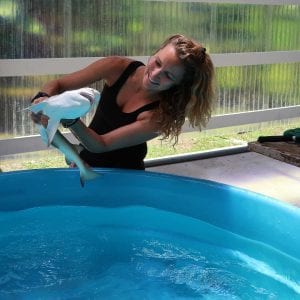
Not long after we’ve placed the 50-meter gill net, and just before the sun sets, we get our first splash. Not one, but two lemon sharks are caught. We free them immediately and take them to our work station right next to this artificial seawall. It’s October and the peak of the pupping season around Moorea, so we are not really surprised – but still elated – to find that both pups are newborns. How can we tell? We look at the open umbilicus on their belly. This little wound is the remnant of where the maternal umbilical cord was attached and is a useful indicator for us to determine the age of the pups.
As at Bimini and St Joseph, fieldwork at Moorea is teamwork. The two newborn lemons are getting a full-on investigation. First, it’s my turn. With the help of my colleagues Ian Bouyoucos and Dr Jodie Rummer, I measure the sharks’ size, weight and their girth. Measuring girth is as quickly done as measuring the pup’s size and body weight. These measurements, if repeatedly applied in different early-life stages, allow me to better understand how the sharks are doing during the first weeks/months of their life. After these measurements, while holding the shark in the water, we flush its stomach with a tube and seawater. This ‘flushing’ or in technical terms ‘gastric lavage’ allows me to obtain prey items. Like the stomach eversion in Bimini, the gastric lavage does not harm the pups, but allows us to study the sharks’ diet. Compared to the stomach eversion this method is even faster and does not require small enclosure pens for the sharks to recover, because we don’t need to anaesthetize the sharks for this method. Only five minutes have passed, and my measurements/methods are finished. It’s Jodie and Ian’s turn. Their objectives are different but actually connected to mine. They are looking at how the higher ocean temperatures that are predicted with climate change will influence young sharks’ metabolic rates after brief gill net captures. Although French Polynesia, like The Bahamas, is a shark sanctuary, young sharks here still risk being caught as by-catch (incidental catch) and are chased by predators – and rising ocean temperatures are likely to exacerbate these stressors. Sharks in tropical near-shore habitats may already be living close to their thermal tolerance limits; warmer seas might prove too much of a threat to them and the future of their ecosystems.
It’s now 9.45 pm and we are cleaning our gear back at the CRIOBE and preparing equipment for the following day, chatting all the while about our findings. This great working collaboration with Ian and Jodie gives me insights into another angle of human impact on young sharks. Not only do we have a direct impact on sharks by altering near-shore areas, but we also exert an indirect threat by increasing global sea temperatures via our carbon emissions in the atmosphere.
Still agitated by this information, we switch our after-work conversation to my objectives, which are also not very promising. Less than half the sharks we have investigated over the past months here in Moorea had prey items in their stomachs. While it is natural that newborn sharks need a few days to weeks to learn how to forage for themselves, the frequency of sharks with prey items is much lower here at Moorea than at St Joseph, I explain. Indeed, 85% of the investigated pups from St. Joseph had food items in their stomachs, while in Moorea stomachs with prey items were only found in 47% of the captured pups. As a result of this insufficient foraging success, I found that the Moorea pups are losing body condition (decreasing girth during their first weeks of life. This pattern, I add, is not evident from St. Joseph. Still chatting about our findings, we close the door of the laboratory and inhale the humid air of another starry Polynesian night.
A juvenile blacktip reef shark is measured in Moorea, French Polynesia. Photo © Dom Leoture.
THE FUTURE
Looking back at these fieldwork experiences, I realise how different the habitats for young sharks can be. Bimini, St Joseph and Moorea are all home to young sharks because they all exhibit unique characteristics that young sharks need to grow up: a shallow protected habitat with ample prey resources. So what will happen to young sharks as we complicate their first, most vulnerable years with more coastal development, pollution, more fishing pressure and rising sea temperatures? Will there be enough food for them? Will sharks be able to adapt? Will we be able to reduce our carbon emissions, a significant contributor to rising temperatures, with an ever-increasing world population? Will we be able to act together as humans to make a difference?
These are big questions and we’re only just starting to understand how our actions may impact young sharks growing up in these shallow coastal waters. While I won’t be able to answer all these questions during the course of my PhD, or even my entire career, it’s hugely motivating to contribute my small part to this challenging field. I sincerely hope that we humans will realise that protecting nature is no longer optional. As Jacques-Yves Cousteau said, ‘For most of history, man has had to fight nature to survive; in this century, he is beginning to realise that, in order to survive, he must protect it.’


